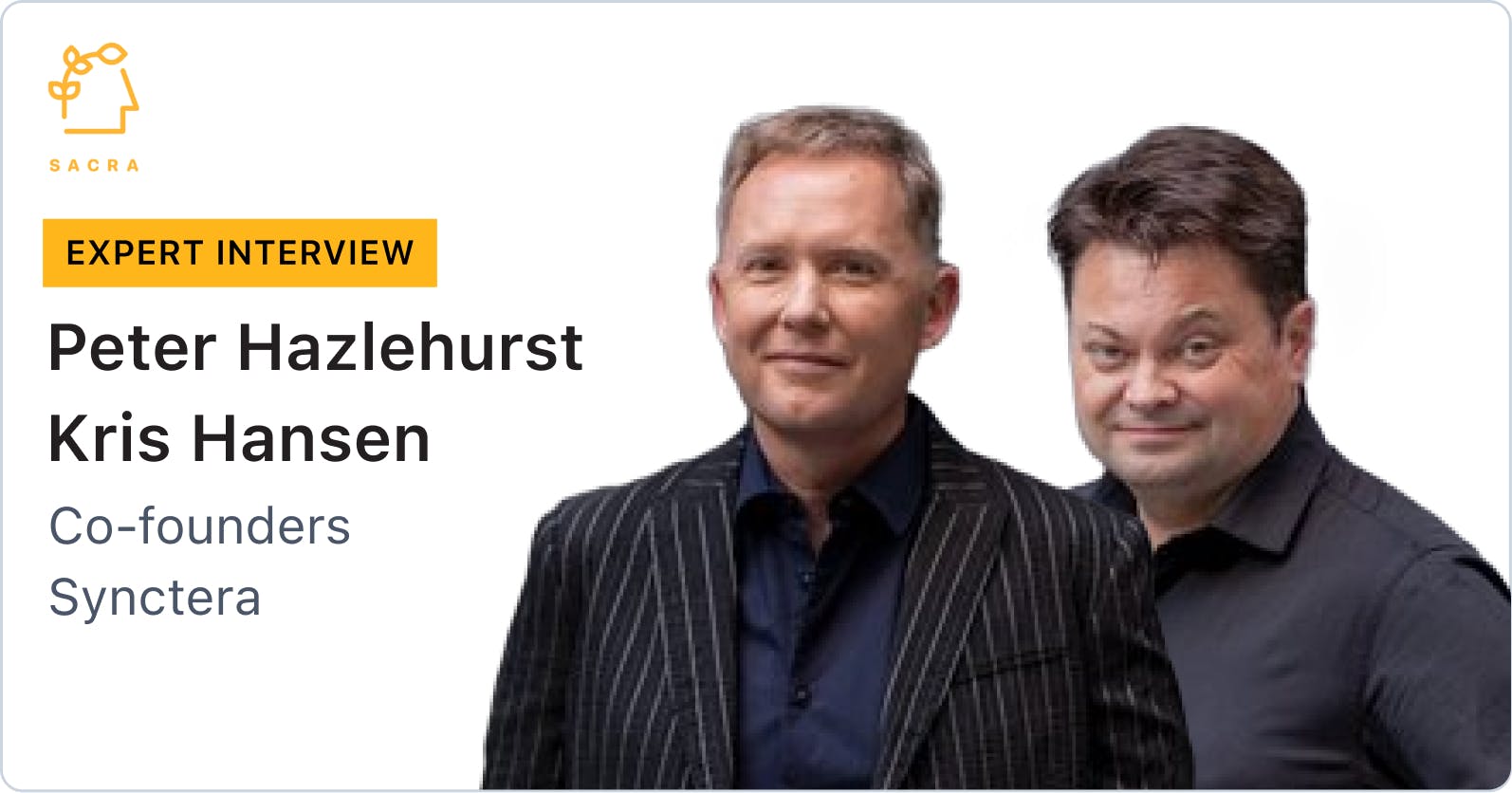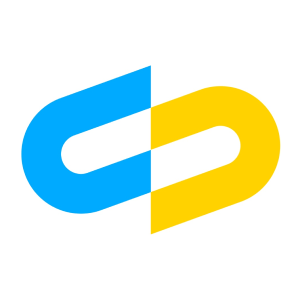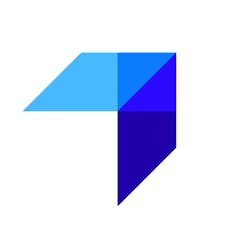Peter Hazlehurst and Kris Hansen, co-founders of Synctera, on BaaS in 2023
 Jan-Erik Asplund
Jan-Erik Asplund

Background
Peter Hazlehurst (CEO) and Kris Hansen (CTO) are the co-founders of banking-as-a-service platform Synctera. We talked with Peter and Kris to learn more about how the relationship between banks and fintechs is changing with recent issues with banks like Evolve, the future of the BaaS business model, and the potential of "vertical BaaS" businesses like those of Cross River Bank and Column.
Questions
- Kris, tell us a bit about your background. How did you come to co-found Synctera?
- 2022 was obviously an interesting time for fintechs. Could you give us your take on what’s happened over the last year, especially when it comes to fintechs and their relationships with banks—and how those are being mediated by BaaS partners like yourselves?
- You mentioned globalization of work and embedded finance as big trends here. What are the other major trends that you see powering the growth of fintechs and BaaS? Are challenger banks still a major one that you’re seeing?
- Synctera, as a BaaS platform, gives banks a kind of “godmode” into what’s happening with the fintechs they’re integrated with. What are the some of the advantages and disadvantages of offering that kind of access that’s unusual across BaaS platforms?
- Is there a trade-off here between, on the one hand, collaborating with the bank and maybe growing more slowly and towards fintech business models that are not so far out on the risk curve vs. going more quickly, abstracting more of that relationship away, and taking on more risk?
- Do you see gravity shifting to where now there's more of an expectation that fintechs manage their own program vs. trying to abstract that away to BaaS providers in order to move faster?
- What’s your take on vertical banks or banks like Column and Cross River that also have this BaaS functionality? Are there competitive dynamics, or do you see them potentially as customers of Synctera's compliance and risk management?
- Do you potentially see a world where 5, 10, 20 years down, there are both, small community banks using a marketplace, like Synctera, to get customers via the fintechs, and some range of vertical banks, a la Cross River, doing the same for a certain subset of customers? Is there a future where both coexist?
- When you say "talk about deal flow," it seems like Synctera's model is more tailored to be bank friendly than, say, other BaaS platforms. Do you find yourselves aggregating the banks faster than fintechs enabling better access to banks on the supply side?
- You started off with a more supply-first approach. Obviously, that was when fintech looked very different. Has that changed?
- Is it that some of the ideas that are not finding homes are the ones doing cannabis, gambling, and sneaker resale? Or is it that there's just such a large volume that there's not enough banks currently in the marketplace to meet it?
Interview
Kris, tell us a bit about your background. How did you come to co-found Synctera?
I’m Kris Hansen, co-founder, CTO. I started in tech. I started one of the first internet providers in Canada back in 1993, and was pretty focused on just doing tech stuff. What I started became the largest technology company in the Hawaiian Islands, mostly just working on complicated problems, insurance, a little bit of banking, government systems, defense, etc.
When I sold my interest in that company and moved back to Canada, a friend of mine convinced me to join a bank. I had an earn out. I was trying to figure out what to do. I wasn't allowed to do a bunch of stuff, but joining a bank would be fun, he said. It'd be relaxing, I could ride out my earn out, and have a good time.
It wasn't fun or relaxing, because we blew up the bank and replaced 99% of the tech in four years. It was a bank with about a billion customers and $26 billion in assets.
I became the chief architect on the transformation, and we spent about $360 million Canadian Dollars and went live one weekend after four years. There was a lot of stuff we had to figure out to do that.
While I didn't have a relaxing time, I did end up learning a lot about banking, and not just the “what” of banking, but also the “why.” If we saw six loan systems, we weren't going to replace it with six. That was just what they ended up with over time. We had to understand all of the different loan products, make sure that it made sense, and come back with one system that just worked.
From there I worked with Royal Bank of Canada—Canada's largest bank—and in 2012, I started focusing on fintech.
The last thing that I worked on—I was the CTO at Koho Financial, Canada's leading challenger bank, reportedly just under a million customers—I started as the fourth engineer, and built a team up to about 100 engineers while I was there. Part of my learning at Koho was, a lot of the things that should be really easy when you're building a challenger bank are almost impossible, and a lot of the agreements that we started with didn't scale.
So we had these two problems—every time we wanted to add to the product, we would go back to the bank we partnered with and say, "Hey! We want to add this product." Sometimes the bank would say, "No. We're not interested," so we'd add another partner.
In my tenure there, we went from one sponsored partner to ultimately, ten partners. Then, we started to see this end-of-the-end complexity problem, where we'd want to change the onboarding flow, so we'd go back to bank one and they'd say, "Fine," and then, we'd go to bank two and they'd say, "Sure." Bank Three would say, "No," and we'd start again.
I started to really think there needs to be some kind of abstraction layer on just how this relationship works.
I really liked having that direct relationship with the bank, because sometimes there's stuff that they could help us with, but the technical integration wasn't great. There was a lot of stuff they didn't have, and there needed to be something kind of facilitating that whole process.
When I think about what we're building at Synctera over two-and-a-half years, I've been able to empathize with the integrator, having been an integrator myself.
2022 was obviously an interesting time for fintechs. Could you give us your take on what’s happened over the last year, especially when it comes to fintechs and their relationships with banks—and how those are being mediated by BaaS partners like yourselves?
We’ll give you a timeline of how things evolved for us. We started a bit over two years ago with a coming out party in Vegas at Money20/20 in October of 2021, and we used that as a way to tell the world, "Hey! We exist. We have APIs. You can start coding. Come on and see what you want to go build."
We were pretty confident we knew what we were doing, but there's always that sort of dodgy feeling of, "Is it going to work? Are people going to come to your party?"
We were really lucky in Q1—October-March 2022. We had a number of folks sign up to use our APIs, and to build and test etc. Most of those were early stage startups, like seed and pre-seed, which have a high beta of, "Will they get to the next funding level?"
About half of them didn't make it, and that's okay. They might have had a better chance if fintech, in general, hadn't gone through a trough, but the market was maturing. There were lots of folks with interesting ideas.
We had four pet banks—people creating affinity experiences for neobanks for pets—that came to us in the first quarter. One of them—Sincere—survived. They're doing great and fortunately, they're powered by us. The founder stuck to his knittings, stayed focused on market dynamics, built a really good product, and my intuition is he'll start fundraising pretty shortly here, so he's doing great.
In Q2, based on the success of Q1, we said, "Maybe we should start charging minimums, and test whether people actually believe there's value in what we do, not just the technology." because it's really easy to find a contract that doesn't have any commitment.
Q2, for us, was quite interesting. What happened was we ended up moving quite quickly into series A and B funded startups and tech companies, and we landed our first big fintech—that was in the cannabis industry, which is really interesting and stretched us in that vertical.
One of our really great clients, Float, which is a corporate card spending platform from Canada, was a really interesting test. They signed April 19, and they did their first transaction June 19, which is pretty amazing.
It was very, very quick, which showed that if you were going to build embedded finance and/or tech in our space, and we can help you build it, you can actually launch quite quickly. We got them up and running and they're going very well now, particularly cornering the market on this idea of, "I'm a Canadian company. I have spend in the US. How do I manage that, and how do I handle that?"
In Q3—this is just after everything's starting to feel very squeamish in the fintech universe—we signed 17 deals, all of which were Series B and C funded startups. We actually moved up the experience curve really quickly.
When you first build your APIs, you want to have a distribution of folks that are going to experiment and try. For us as a team, on the operations and the compliance side of things, you don't actually want any of them to be too big at the beginning, because you know you're going to have some problems—the bugs and stuff that you want to work through—and you don't want to discover that bug with 150,000 users. You want to discover it with 10.
After Q3, we went into Money20/20 in Vegas and continued the acceleration.
I know that there's been a lot of stress in the ecosystem around our startups getting funded etc. What's clear to us is that there are vast numbers of founders out there with great ideas and/or existing companies that know what they're doing and they want to add banking or payment services to them.
And the value prop that we have for them is really good, which is, "We'll keep doing what you're doing. We'll do all the complicated banking stuff, and bring you a bank. We'll manage the compliance and all of the complexity that you don't want to need to know anything about." If you're an expert at building software to manage nail salons, do you really want to understand how to build a neobank for your team members? Probably not. But do you want the revenue? Yeah, you do.
I don't think every company's going to be a fintech, but lots are. The use case, like we had at Uber when we launched Uber Money—a neobank for the drivers—that use case exists in many different sorts of verticals. The speeding up of time around expectations of, "I did work here. I want to get paid now or tomorrow, not next week or next month," that's making a big difference.
The other thing that we're seeing a lot of is a globalization of work.
One of the things that happened, as part of the pandemic, is this notion of, you had to come to an office. "If you're a US company, you have to hire US workers," but that’s fallen by the wayside.
What's now becoming important or interesting is talent has always been globally distributed, but it's been hard to access. With Zoom and everything else, people are able to work and collaborate on projects and teams, so, if I need a graphics designer, I don't have to say, "Is so-and-so from Silicon Valley available?" I could find someone in Detroit, or just as easily in Mexico City. The challenge is, if they're international, how do you pay them?
We're seeing a number of fintechs come to us and saying, "We've got a universe of workers that are working in the US that want US bank accounts. Can you help us bank them?" We're seeing some trends that are happening.
Embedded finance is definitely ramping up. Globalization is definitely ramping up, and we are lucky that we built a network of 10 banks with different levels of risk appetites and different approaches to wanting to bank different types of customers, because we can mix and match. We can say, "This fintech, straight down the middle, we can match you to any of our banks. This fintech is doing cannabis. Right now, we match you to Regent Bank, which is our cannabis-friendly bank in Oklahoma," etc. That's given us some really interesting leverage.
You mentioned globalization of work and embedded finance as big trends here. What are the other major trends that you see powering the growth of fintechs and BaaS? Are challenger banks still a major one that you’re seeing?
There are so many verticals, where there's an existing something, that adding banking to it is really easy. One of the great companies we're working with is called Players Health.
Ty, the founder, was focused on how he could bring kids into sport in a safe and productive way. It turns out one of the big challenges for parents of kids playing sport is economic.
Imagine you've got an amazing kid that gets in the football team. Just equipment alone and all of that stuff for the team costs a lot, then you have membership fees, and so on. Many parents don't have the cash up front to pay for it, so what we're working with him on is this idea of spreading out those costs—like BNPL but for kids’ sports.
There's a second order of business problem, which is actually non-obvious, but when you think about it, it's really in your face.
On opening day, many parents walk in with $500 in cash and say they want to pay their kid’s fees. If you're the team manager, you end up with $10 grand sitting in your pocket.
If you put it in your bank account, the IRS says, "Hey! You just got income."
Overall, it’s not like he's creating a neobank for sports players—what he's doing is adding banking services to an existing vertical or a slice of the universe. We’re helping solve some of these interesting adjacent problems.
The other trend is quite interesting and I hadn't actually envisioned this as B2B2B and B2B2C, where we've got people that are coming in and saying, "Hey, listen. I'm an expert in this area. I'm already doing, for example, dealer finance, but now I want to do all my dealer's banking. I want to offer them a checking account. I want to offer them payroll service." And the reason that—if I'm in the dealer finance business and I'm really good at that—is, I want the rest of that relationship largely for insight, information, to understand, and be able to predict risk better than I could before.
I didn't really realize that all these little businesses exist, where I just do dealer finance for recreational vehicles—and I'm really good at it. I help them buy the units at auction, put them on the floor space. Now I want to offer deposit accounts, payroll. I want to do cards and manage the expenses.
It's interesting to see how these businesses are looking to grow by adding financial services to it. It’s a similar sort of scenario for the cannabis industry and dispensary management.
It isn’t just about enabling payments in that industry but about offering a financial services experience for a dispensary owner, that probably hasn't had one before because they've all been kind of scrambling to patch things together. That's been really interesting.
There's been other programs around real estate investment, where we've got people that are coming together and saying, "Hey! Let's buy that building," pulling the funds together, doing the syndication, but then also, "Let's service the rental in the building and disperse the rents back to the original investors," and things like that. The theme, I would say then, is fintech started in a very retail way.
It was retail banking and retail experience that is graduating into much more what we would consider, in the industry, more commercial style patterns—more business banking, commercial banking, even beyond SMB. Everybody's familiar with the SMB use cases, but it's going upstream.
On the embedded side, the big brands want to know more about their customers. They see these customers as assets, and they're done with these blind, white label deals, where they just sign over a card and get a $50 referral fee and walk away.
They don't care about the referral fee anymore but want the insights and to understand, "What are consumers doing outside of their operation and why? Where should they build their next location? How should they evolve their business?" It's much more about having that kind of proximity to the customer and really knowing them than just extending the brand.
Synctera, as a BaaS platform, gives banks a kind of “godmode” into what’s happening with the fintechs they’re integrated with. What are the some of the advantages and disadvantages of offering that kind of access that’s unusual across BaaS platforms?
Building a BaaS platform is fundamentally just hard. Doing it right entails a lot of fixed cost engineering and product work.
One of the things that's particularly challenging is, when you work the way we work, where each checking account or savings account is rolled up into one giant checking account at the bank, called an FBO (For Benefit Of) account, if you are at the bank, all of the tools and infrastructure you have at your bank doesn't actually apply.
Normally, in a core banking system, you have dashboards that say, "Yesterday we onboarded 500 new customers, and yesterday, 7,000 transactions occurred," etc. With an FBO model, all they see in their core banking system is there's a giant checking account with $6 million in it.
Historically, many of the banks didn't push hard enough to say, "I want visibility into everything that's happening downstream inside those accounts, and because I'm responsible, I need to know. Please, tech provider," or fintech alone, because a number of these fintech programs, there was no banking service provider at all. It was just fintech-to-bank. "Give me visibility into it."
So what started to be generated were maybe weekly or monthly export files, like dashboard, "Here's a list of all my customers, and a list of my transactions.” But the prerequisite of that is something on the other side at the bank to ingest that and do analytics, thinking, and flag transactions for KYC, money laundering etc.
We took a fundamentally different approach, which was to say the data in our program has permission-based access depending on who you are and what you're doing.
As a consumer, it's your data. That's pretty straightforward. When you log into your mobile app, you should be able to see your transactions and have transparency as to where the money went, if there's a hold on my account because I went to the gas station etc. Then, it's pretty obvious that, as a fintech, you want to be able to look at that data in a PII-sensitive way.
So you probably don't want to see each individual consumer’s first and last name and things like that, because you are really focused on the analytics—"What's my KYC funnel? Is everybody failing because they're putting in their address wrong?" That sort of stuff.
We added the raw ledger, the core of this infrastructure, and we said, "Consumers, you get access to your data. Fintechs, you get access to your fintech consumers data. We, Synctera, have visibility." Then we said, "Hey! Bank.
You have access to all the fintech's data and all of the consumers within that," and then we, Synctera, sit across all of them with the ability to say, "Hey! I'm spotting trends of bad behavior over in one fintech, and it's bleeding into another," or "This fintech's doing really well. That one's not doing so great. What can we do to help them?" Building that is actually hard, and we are lucky. We had Kris on our team design an architecture for the ledger, the core that incorporated that from the get-go.
Now, the next evolution of that is actually multi-bank support, which is one fintech spanning multiple banks with their customers distributed across them, and making that easy from an analytic and a thinking perspective. If you don't have that, everything else becomes more challenging.
If you're a bank and say, "Hey! Show me my exposure to transactions over $1000 across all of my customers?" and you don't have access to the data, how do you do it? You can't do it because, based on the information in the FBO account, it's not there. In the FBO account, you have three or four transactions a day, a total settlement from ACH, MasterCard or Visa, inflows and outflows, and say, the fintech is generating interest on deposits—there's going to be some math around that.
Why this becomes a challenge for the banks, from a regulatory perspective, is they really need to know. There's been a really good amount of energy lately of helping get access to the information in a thoughtful and safe way, which creates a lot of work. So, if you start from the beginning with that as a premise, it's actually relatively easy to manage the who-can-see-what. You have to do a lot of testing to make sure people can only see what they're supposed to see and that sort of thing.
Atop that, we built a case management system. Ultimately, let's say a transaction is over a limit. You said, "No more transactions over $1000. This user is swiping for $1200." We decline that transaction. Immediately, we create a functional case, and that gets escalated to the fintech and says, "Hey! You're over your limit. What do you want to do?" It may also go to the bank saying, "Hey! This fintech would like a higher limit. Will you give them one?"
We use that as an orchestration between all of the parties—fintech, bank, us—and those two things, the ledger, the core banking system, the case management, aka the workflow system, plugged in together creates this really interesting framework, where you can build lots of unique, interesting, and special cases.
This customer seems to be the same customer over at this other fintech, and we know we had fraud on that customer before, so we introduced the banner product that basically says, "We know for sure this is a bad actor. If we ever see them again on the platform, we're also going to equally treat them in a negative way," but then, you need an appeals process if we get it wrong. So you've got to make sure you've got the ability for people to get out of that problem space if we misidentify someone and so on.
So that's what we built, and because we are running it all in the cloud across multiple banks and fintechs, we have this unique insight as to what's happening. It allows us to then help and instruct our banks on where you should care. It helps them be more efficient so, if they've got other tools on their side that they want to import the data into—either in real time or in batch—we can do that, as well.
There's a couple of really important concepts that we started with, that I think has proven very helpful.
One is that the bank and the fintech are looking at the same page. They're looking at the same number, at the same customer information. They both have equal access to what's going on. I've experienced other models, where the bank calls us and says, "What's going on? We can't find that number." Everybody scrambles around for three days. Here, the concept is everybody's looking at the same page.
The other is that the bank is always able to supervise and oversee how cases are being responded to and closed. This helps facilitate a kind of coaching mechanism like, "Hey! Let's do it like this." It creates this environment where Synctera, the bank, and the integrator or the fintech are all in it together.
The other thing that's really cool is—and we have a marketing term for it—the Synctera Protect. One of the things that we built is a rule engine that we used to call Trust and Verify. If the integrator gives us information, the API, that's fantastic. Everything looks great, but Rule Checker actually looks at the integrity of the records, the regulations, the details of the program, and flags a case if anything looks unusual.
For example, "Hey! Someone KYC'd and that looks good. They onboarded a card and signed up for a new card." but we don't see a cardholder agreement disclosure acknowledged in that flow. The concept here was that of customer journey analytics basically looking at a customer's journey, and trying to nudge them in the direction of doing the right things on your platform so that you can have a more successful platform from a marketing perspective.
We're looking at the customer's regulatory journey, and if anything looks weird, we say, "That's a case." Someone has to look at that. We have to review that. That's helped us find the things that we don't know. If there's a small bug, for example, in an integrator's app, and they forget to do disclosures, you can easily onboard 10,000 customers that you shouldn't have. So, looking for these things, having this kind of safety net that's also looking at the flow, the data, and the events has been very useful for us.
Is there a trade-off here between, on the one hand, collaborating with the bank and maybe growing more slowly and towards fintech business models that are not so far out on the risk curve vs. going more quickly, abstracting more of that relationship away, and taking on more risk?
It is a trade-off, and the bottom line is that you just can't short-change compliance. The most basic part of banking in the US, and in general, is “Do you know who this person is that you are banking?” aka KYC (Know Your Customer), or Customer Identification Program, CIP.
Second, “If you can prove that that is who they are, are they the person interacting with you at this point in time?”
So, it's the real-time identity verification, because a lot of times you could actually pass KYC, and then, something bad happens—a person has identity theft or their account gets taken over and stolen. The challenge for earlier tech startups in this space was it was a lot of work and considerable code to do a really effective KYC program to identify the consumer. It's also materially hard to keep track of, "Is this the person that we started onboarding a long time ago?"
Google and Facebook get hit with identity theft all the time, and they have vast teams of people thinking about the data, and making sure that someone's not stealing your Gmail account. Every few hours, people still try and hack into my Hotmail account. Why they want to get into my Hotmail account? I don't know. But I enjoy seeing these alerts from Microsoft.
Our job at Synctera is to build a tech stack that makes it easier for a fintech to build those minimum things, and appropriate controls and constraints for the banks to make sure that they're providing the oversight to ensure that the fintech is doing what they're supposed to do. That’s because ultimately, the bank has to know who the customer is and they have to feel comfortable that the customer is doing the activity that they say they're doing—it was them when they swiped the card. If they can't do that, they run the risk of getting in trouble, and bad things can happen—money laundering can happen, accounts get stolen, fraud etc.
I think the challenge that you have in this category is, you've got a bunch of people in adjacent businesses—persons wanting to create a neobank for Lego users—they know everything about Lego and don't know anything about banking. I just finished building the Coliseum. It took a long time; however, does the Lego Corporation understand the rules of know-your-customer, how old do you have to be to be a bank account holder, and all of that? They don't. If they applied their normal growth patterns of referrals, P2P, references, etc., without putting the safeguards on the banking side, the banking system would fall apart. So, yeah, it’s a very real trade-off. You could easily onboard 100,000 people if you did it anonymously.
Look at that crazy fintech called ZELF that basically literally said, "I pin Vladimir Putin's name, and we'll give you a bank account." No one should be able to do that. There are things you can do to improve your KYC funnel to make it better. If you see someone typing a PO box in, say, "PO boxes are not valid. Don't bother. Come back again." That way, you can make it an improved cycle, but you can't avoid it. Trying to avoid it is just going to expose the market to risk.
Our commitment to our banks and fintechs is, "We're not going to let you take unnecessary risk." There's definitely risk you can choose to take, saying you can swipe a card for a bigger dollar amount and what do you want to do with the fraud when it goes bad? Those things are, what I would call, acceptable risks based on the tradition—the history of the relationship with the customer. But the first swipe with a community, a debit card for $150,000 of AdWords, you probably should say no, let them grow into it, and start with $1000 limit, and then a $5000 limit, and then a $10000 limit.
All of this stuff we have learned over the last 200 years of banking is, there's risking by design in banking. There's leverage risk of, "You're giving a loan to someone. Hopefully they'll pay you back." To fund that loan, you've got deposit risk of, "Hey! These customers are putting their checking accounts with us. We hope they don't all come and take all of their money out all at the same time, because if they do, how are we going to cover our loans?" Then, managing risk is what banks are really good at. Our job in the tech and the banking service world, is to give them the tools that they would normally have to manage risk at the bank for their fintech customers too.
The last year has really confirmed our model and approach, and we really did start with a different philosophy around BaaS, where we're not trying to abstract that relationship between the bank and the integrator. We're trying to facilitate it. To the integrator, we're a collection of great APIs and an operational platform to help them manage their program. To the bank, we're a sleep aid to help them feel comfortable about how they're running this program. Our banks log in every day, spend time on our platform looking at their book and understanding who's coming in, where's the money going, what are the risks, what's the program? That's what we wanted—to be the facilitator of this, not to be abstracting it.
That was the part that concerned me most when I started looking at this industry and how it was being done. It felt like banks were kind of flying blind in these partnerships, stepping in with some BSA audits every once in a while. To me, it's just not enough. “We're in this business together. We've got to pay attention,” was the philosophy, so, it's actually been really rewarding to just see that people like the platform, they're using it, getting utility out of it, working together, and working the book together.
Do you see gravity shifting to where now there's more of an expectation that fintechs manage their own program vs. trying to abstract that away to BaaS providers in order to move faster?
In our model, the traditional program management is embedded in and facilitated by our platform. So, we have a concept of a product template, which will define the limits, the attributes, and the characteristics of—if it's a card program—of the card account and the underlying relationship that the account has with the card. We're thinning out what it means to be the program manager. Now, we provide coaching along the way for the integrator that's looking to do things, and the bank is obviously paying attention as well to the program attributes and characteristics, but, if you do this really well, that traditional program management really gets infused into and combined with issuing, processing, and other aspects, which in our platform, are templated and part of the configuration of what you're launching.
The interesting part about this generic is the legal definition of program manager, if you will, is being blurred away from, “either it's the bank or it's the fintech,” and what we are doing is helping all sides manage the program, successfully. We help them with the tooling and technology. We have an ops team and support team to help them follow up with the transaction that went bad etc. We call that team Ground Control. The fintech themselves have some aspect of responsibility here of making sure that they're doing KYC reviews on behalf of the bank and under the supervision of the bank. We can help facilitate that and help them participate, but the bilateral relationship is more effective when you have extra people helping out along the way.
What’s your take on vertical banks or banks like Column and Cross River that also have this BaaS functionality? Are there competitive dynamics, or do you see them potentially as customers of Synctera's compliance and risk management?
Our tech stack will work with any bank. That's the starting point. It's optimized for community banks under $10 billion in assets because of Durban. However, we've started to engage with bigger banks, because we now have these things called smart charge cards—a charge card out front which runs on the credit rails and is backed by a checking account on the backend, which allows the bigger banks, to participate, which is really attractive to them.
The folks like Cross River and Column, that have said from the get-go, "We want to be a tech-forward bank, and we want to have our own stack internally that we share with our fintech partners etc.," are awesome. It's a high burden, so they're very different disciplines. The discipline of being a banker versus the difference of being a technologist—they're quite different.
The really, really big banks, like Bank of America and Chase, have tens of thousands of people in their organization to do the tech stuff and tens of thousand people to do the banking stuff. If you're a small community bank, you can't afford that. You outsource all of your tech stack to [inaudible 00:45:43], Jack Henry, or one of those tech providers. It's when you get blurry—and the early banks like MetaBank, aka Pathward now, and Green Dot and others did a little bit of this—that you say, "We're going to both be a community bank and this." One of our customers, Coastal Community Bank, has been quite successful at being a retail bank in the Seattle, Washington area, and has allowed fintechs to connect to the bank, but it's relatively unusual.
Completely tech-forward banks have been few and far between. Column is a good one. Cross River has built an amazing franchise. They've been in the game for a long time, and they're a very strong partner, potential partner, but even they have scalability concerns or limitations. It won't surprise me that folks like them will come to us eventually and say, "Hey! Can we work together?" We, Synctera, have a great deal flow, and we can help them get into the market faster than if they were trying to close every deal themselves and have that ecosystem.
What's pretty clear in this market is developers’ zeitgeist, productivity, and engineering success are really strong differentiators. As a bank-bank, you've got this dual hat that you have to wear. "Can I build the stuff to run the bank, and can I build tech stuff?" Unless you're really well capitalized and capitalized like a software company, not a bank, it'll be hard for you to divert the resources necessary to be competitive, unless you're Bank of America, or Chase, or whatever.
I think there's something really powerful about having a marketplace with multiple banks in it, and the deal dynamics of who wants what deal is not exactly what I expected. A lot of it really just comes down to chemistry. Some banks really like certain deals and certain founders, and there's a chemistry that exists there. I think, for the banks that are really looking at investing in this—it's a very capital heavy activity. You're going to build an engineering team, maintain this stuff, manage it and on top of that, you're not going to want to take all the deals.
There's a matching problem here of finding the right deals for the right banks. I think, ultimately, a marketplace approach wins, and I hope it's us that is the winner with that approach, but I think ultimately banking is about assessing risk and being able to launch the right programs with the right risk understanding and being able to price that risk. Ultimately, it comes down to reducing the friction of that marketplace to just make that happen as effectively as possible. It's been great for us to see. When our banks get together with our integrators, and they've got that chemistry, and our platform facilitates the tech side of it—to see that relationship really flourish and grow has been really powerful for us.
Do you potentially see a world where 5, 10, 20 years down, there are both, small community banks using a marketplace, like Synctera, to get customers via the fintechs, and some range of vertical banks, a la Cross River, doing the same for a certain subset of customers? Is there a future where both coexist?
Yeah, and I see a future state where we at Synctera would say, "We'd love to work with you, Cross River. We have a bunch of lending programs that don't land naturally at some of our community banks. Would you like to have access to those deals?" They've got really great expertise over there in that category.
For example, we have one bank region that does cannabis banking, and if you're a fintech and you want to do cannabis, there's actually a very finite number of places you can go, find a banking partner.
We are very lucky to have one. Same sort of thing where there's specialization of the bank's capabilities like there are some banks that will be comfortable with taking eSports, gambling, and other use cases. With a marketplace of banking in general, as an end consumer, you say, "Which is the right bank for me?" Whether I want B of A, Chase, Chime, or whatever.
The same thing, then, applies to the companies. Who do you want your business checking account with? Traditionally, if you're a small mom-and-pop store in Main Street Iowa, you're going to go to the local branch in town. That's where you go, because you know B of A, but you'd rather bank with the person who puts the uniforms on the kids that go to school and play on the football team.
Our job is to take that hometown community experience, bring it out onto the internet, like everything else that's gone there. If you think about it, banking is still relatively retrograde compared to social media and other sorts of things in its approach to internet aggregation of consumers. If we can get it right, then, the marketplace is really healthy, because it allows us, based on the profile of the consumer segment, to find you the right home on the backend.
When you say "talk about deal flow," it seems like Synctera's model is more tailored to be bank friendly than, say, other BaaS platforms. Do you find yourselves aggregating the banks faster than fintechs enabling better access to banks on the supply side?
We have had banks that have told us that they decided on us because of that experience in our admin platform. In that whole flow, that was a deciding factor for them.
It's definitely a marketplace, though. It's just like Uber. You've got to have enough supply in order to deal with demand. Right now, there still remains to be very high inbound demand for us from a fintech perspective. "I want to launch this in 60, 90 days. Can you help me?"
Our ability, then, to round-robin or allocate those deals to the banks so that all the banks feel like they're getting interesting deal flow themselves, and feel like they're growing with us, is an important balancing act that we have to do to keep the marketplace healthy. At some point, we're going to get to a place where there's so much inbound, that we need to add more banks to the platform, and then, we'll be quite selective.
Right now, we're actively looking for a second bank for cannabis to de-risk just having all our eggs in one basket. That's both a fintech request and a bank request. "Hey, can you help distribute the load as we go?" So it's this constant balancing act.
Generally speaking, we took a supply-first approach at the beginning to help make sure that we knew that there was effectively infinite demand on the consumer side and the fintech side, so, if we couldn't satisfy that demand by having banks that we could work with, that would take on the use case, we would end up unsatisfying the fintech community.
You started off with a more supply-first approach. Obviously, that was when fintech looked very different. Has that changed?
I think that the supply-demand imbalance is still real. There are way more fintechs and embedded finance use cases than there are homes for them to land on banks. We've got some, and unit and treasury prime have other banks, which is great, but there are still way more ideas that want to get built than there are homes for them.
The solution there is to make the supply either more efficient and more effective so each bank can do more deals and/or increase the overall pool of banks that are available in the marketplace, in general. I don't think we've hit an equilibrium, yet. Let's put it that way.
Is it that some of the ideas that are not finding homes are the ones doing cannabis, gambling, and sneaker resale? Or is it that there's just such a large volume that there's not enough banks currently in the marketplace to meet it?
I still think it's the latter. There's definitely a specialization problem space, but that's not actually what I'm most thinking about. I'm thinking about, in 2023, going on onboarding 20 Toasts, and each individual Toast will be demanding for any one of our community banks. So what do I do with the other 10? If I give one to each of my community banks, that’s awesome and fantastic. I'm really happy to have this high velocity customer. But what do I do with the next 10?
That's the constraint in the market, and we're just at the very early stages of getting the next 10 Toasts or vertically integrated fintech business use cases going to market, and there's a lot of them. There's so many use cases that haven't been tapped into, yet.
Disclaimers
This transcript is for information purposes only and does not constitute advice of any type or trade recommendation and should not form the basis of any investment decision. Sacra accepts no liability for the transcript or for any errors, omissions or inaccuracies in respect of it. The views of the experts expressed in the transcript are those of the experts and they are not endorsed by, nor do they represent the opinion of Sacra. Sacra reserves all copyright, intellectual property rights in the transcript. Any modification, copying, displaying, distributing, transmitting, publishing, licensing, creating derivative works from, or selling any transcript is strictly prohibited.






